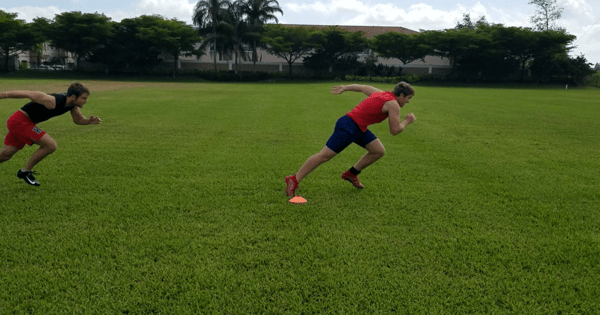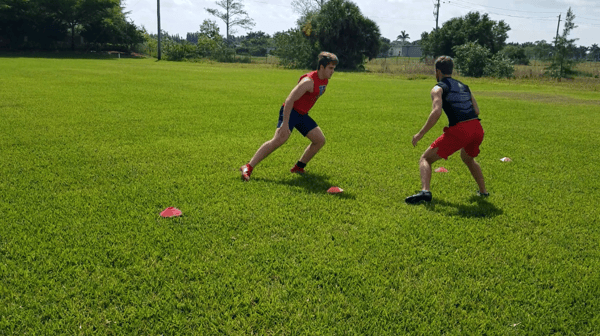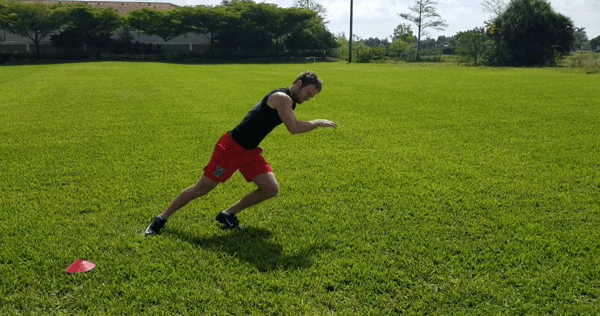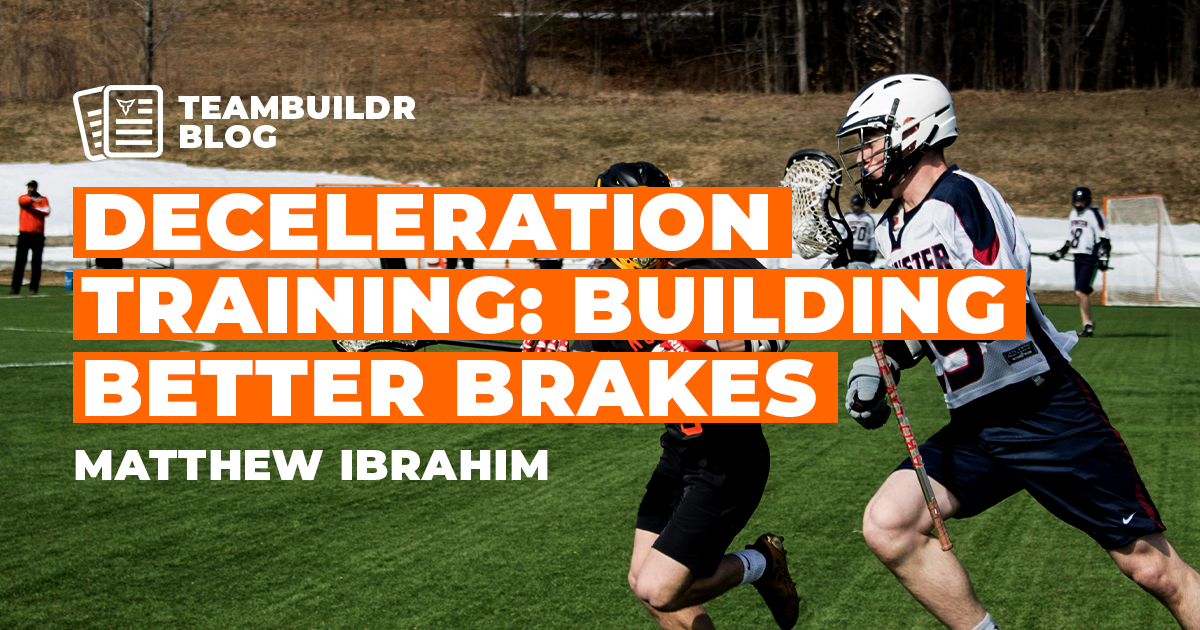Is Teaching Speed Development A Strength Coaches Achilles Heel?
When it comes to getting our athletes faster and better able to change direction, I think a lot of strength and conditioning professionals are drowning in fancy drills and starving for a systematic way to teach correct movement patterns. It is very easy to watch a video or see an article that has a lot of cool looking change of direction drills or linear speed drills and try to add them all into our program immediately, not really knowing where and when they fit into our program.
Most strength and conditioning coaches have some type of system in the weight room, some have fallen in love with the Tier System, some love the APRE approach, some love the 531 Program, either way I think you would be hard pressed to find a strength coach who doesn't use some sort of a system or program in their weight room. We like to use these systems or programs to guide our decisions, set and reps, goals and phases of training. The interesting thing is, when it comes to programming movement on the field or court, most strength coaches have not a clue of what system they use. Most have no progressions, regressions, or goals in mind for what they want their athletes to learn or accomplish from a linear, lateral or multi-directional standpoint.
I have heard that the phrase “this is the way we have always done it” is the most dangerous phrase in our profession, yet I have seen the same coaches who use that phrase go outside, take their athletes through a good warm-up, do a bunch of cone “agility” drills and try to pretend that their athletes got “quicker”. There is typically zero coaching, cueing, or context to what the drill is supposed to be teaching or ingraining in the athletes. No progressions, no regressions, just the same cone drills every week, maybe different by each day, but the same ones every week. I know this from experience--I once did the same and I have talked with many coaches who still do the same, for some reason we are not taught much about speed and agility in school or in most of our internships.
I think this is one area that most strength coaches would call a weakness of theirs and I think this is a weak area in our profession and something that we could change fairly easily. If we all have our favorite systems or models that we use in the weight room for how to progress, regress and teach proper lifts, we should also have a system or model for teaching linear, lateral and multi-directional movement.
The first thing we need to do is simplify all the different types of movements on the field or court that a strength and conditioning professional should be able to teach their athletes.
Our job is to help athletes become stronger, more explosive, mobile in the right areas, stabile in the right areas, faster, better able to change directions and move in different planes of motion, more resilient to injury, and in better condition for their sport.
We are the support staff for sport coaches, we should be making the sport coach’s job easier and making him or her look like a better coach than they actually are in most cases. We should be handing over athletes to their sport coaches at the beginning of the season who are ready to play their sport at their fullest capacity. Our job is not to step on the sport coach’s toes and starting teaching movements that the sport coach is paid to teach. For example, I think if we taught all of our athletes how to accelerate properly we would be doing them a great service. But if we started teaching all of our athletes how to back-pedal, some of our athletes would think we were crazy, some would have zero transfer to their sport, and some sport coaches might get upset that we are teaching something differently than they teach it and now they have to undo all the habits we have built.
We are not track coaches. As the strength coach it's our duty to be knowledgable on lateral and multi-directional movement, deceleration, and change of direction. A track coach would be more knowledgeable on linear speed and max velocity speed. We do not need to know every single detail about how to get someone faster for a 100 meter race. The majority of a 100 meter sprint is made up of absolute speed or max velocity speed and a majority of sports don't use this type of speed much of the time.
So, what do we need to know about how to teach as sports performance professionals? I think it all goes back to the K.I.S.S. method: Keep It Simple Stupid. I think we need to know the basic techniques for the main movements that we know will affect most of the sports that we are trying to impact. So let’s boil all movements that we see in the typical team sports into the main techniques that we should be able to teach our athletes. We all know there is linear speed which resembles a track athlete, the type of speed that we need to run in a straight line but there is also lateral and multi-directional speed.
3 Types Of Speed
Let’s think about linear speed first. For starters there are only really two main types of linear speed: acceleration and absolute speed. Acceleration is very much used in all the team sports that we are trying to impact with our athletes, whereas absolute speed, or max velocity, is used much less. We should know a lot about acceleration, the basic mechanics, how to progress and regress and how to ingrain the right acceleration mechanics into our athlete’s motor programming. On the other hand, as we don't need to know everything about absolute speed, it doesn’t hurt to know, or even educate your athletes top speed mechanics.

When it comes to lateral speed, the main movement we need to know is the lateral shuffle. The shuffle comes into play the majority of team sports; tennis, lacrosse, basketball, baseball, football, etc. It's important to first make sure we establish the right movement patterns of the shuffle and then we can progress that movement by teaching it in a reactionary environment.

The main technique that we should be teaching our athletes to improve their multi-directional speed and change direction effectively is a movement called the cross-over. Again, K.I.S.S. we just need to know the basic mechanics behind the cross-over and how to establish those correct movement patterns with our athletes. Then we progress them from basic drills into more chaotic drills where they use the correct mechanics with a reactionary component.

So, if you really boil it down to the basics of what we should be teaching our athletes that will translate to most, if not all, sports is:
- Acceleration drills for linear speed
- Lateral Shuffle drills for lateral speed
- Cross-Over drills for multi-directional speed
Of course there is room to add one or two movements to this list that could be beneficial but in light of this blog we will keep it simple and focus on these.
Progressive Speed System
Now that we've gone over the three main techniques to teach, we need a system to help guide our decisions just like we do in the weight room. I learned this system very well during my three years at EXOS and have adapted it to fit the needs of my athletes and the large groups that I work with. The beauty of this system though, is that it can be used in a one-on-one setting as well as a large group setting. It is what I call the Progressive Speed System and there are basically three tiers to it. The first level is called technical, the second is pre-programmed and the third is random.
In the technical phase the athletes are only doing drills and movements that are preparing the body to do the movement for that day. These drills are very basic in nature but are great at building context to what you will ask the athletes to do next in the second and third level.
The pre-programmed phase consists of drills that actually use the focused movement of that day but they have no reactionary component to them. In these drills or movements, the athletes know exactly where they are starting and where they are stopping, a good example would be cone based drills. The point of this phase is to take the athletes a little further than just the technical aspects of the movement and see if the movement is still efficient, or if they fall back into bad movement patterns.
Once the athletes have shown proficiency in the technical phase and the pre-programmed phase, it is now time to move them to the random phase and see if the movements you have been focused on are actually being utilized by the athletes or if they fall back into old habits. We would like to get all of our athletes into the random phase before the season starts, depending on how fast they are picking up the techniques in the technical phase and how they look in the pre-programmed phase.
This system is very powerful and very simple at the same time. It allows coaches to take their favorite drills they are already using and new drills they learn at clinics and know exactly when and where they go in their program. It makes speed development very easy to progress towards an actual goal, instead of just throwing random drills at our athletes and hoping something sticks and transfers to the field or court of play.
If you want to learn more about the Progressive Speed System visit evanssportsperformance.com. There are over 30 videos that go through every detail of the system and Coach Evans’ favorite technical, pre-programmed and random drills for acceleration, lateral shuffle and cross-over. Enter the code teambuildr50 to receive $50 off!
Subscribe to our blog
Subscribe to receive the latest blog posts to your inbox every week.
Related posts

Compound Training for the Off Season Athlete

Deceleration Training: Building Better Brakes


